|
YORKTOWN National Battlefield |
 |
Guide to the Area
(continued)
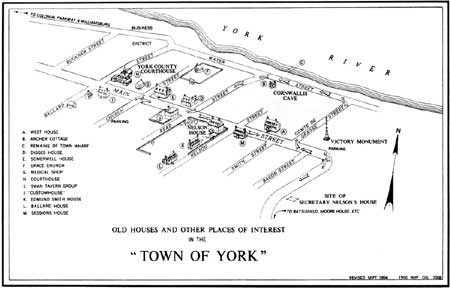
(click on image for an enlargement in a new window)
"TOWN OF YORK"
Much of the old has continued, or is being recaptured, in Yorktown and many of its buildings and sites have their individual messages. In the following text, the letters correspond to those on the map of the "Town of York," page 46.
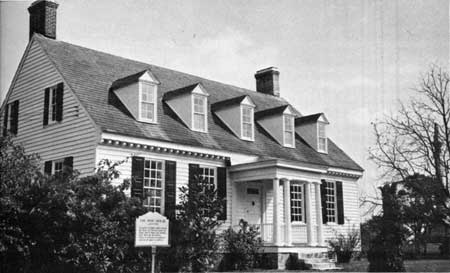
The West House—owned by the Digges family for
a long time
A. West House. This residence is one of the few remaining colonial frame structures in Yorktown. Its inner timbers bear the scars of artillery fire to which it was subjected in 1781. It is thought to date from the mid-18th century.
B. Archer Cottage. Below the bluffs is a small cottage thought to be of colonial origin and to have been property of the Archer family. This is the only surviving structure in this once busy waterfront section of the port of Yorktown.
C. Remains of Town Wharf Rock piles and some of the timber crib of the public wharf which served Yorktown before the Revolution can be seen at exceptionally low tide near the foot of Read Street.
D. Digges House. This brick dwelling, constructed early in the 18th century, stands at the once busy corner of Main and Read Streets.
E. Somerwell House. This restored residence, built, it is thought, before 1707 by Mungo Somerwell, was at one time a part of the Lightfoot family holdings.
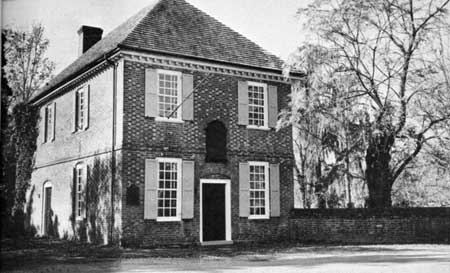
Richard Ambler's storehouse is better known as the
"Customhouse" because he was a customs collector at Yorktown for many
years.
Many of the fine old homes are no longer standing, such as the Lightfoot mansion that is shown so prominently on the sketch of Yorktown made from a vessel in the harbor about 1754 (see pages 34 and 35). The Buckner residence in the west end of town, a second Lightfoot townhouse, two of the spacious home of the Nelsons, and the Ambler dwelling have long since been destroyed, except for foundation remains below ground.
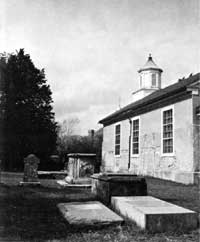 Grace Church. In the foreground are the Nelson family tombs, including Thomas Nelson, Jr.'s. |
F. Grace Church. This church, in York-Hampton Parish, is the oldest in Yorktown. It has been active since its construction about 1697. The present structure incorporated much of the original native marl walls. This church was used for various military purposes in the two wars that engulfed Yorktown, but parish organization has continued unbroken and services are held regularly. In its churchyard lie the remains of prominent men of Yorktown and of many others less well known. The church is normally open every day.
G. Medical Shop. This reconstructed shop is across Main Street from Swan Tavern.
H. York County Courthouse. This structure, the fifth such to stand on Lot 24 in Yorktown, was completed in 1955. Although not a reconstruction, it does capture some of the architectural flavor of the time. It serves the town and county, as buildings on the lot have done since 1697.
I. Swan Tavern Group. This group of reconstructed buildings, including the tavern, kitchen, stable, smokehouse, and privy, all stand on original foundations, One of the characteristics of colonial Yorktown was the large number of its inns and taverns. The Swan, opened for business in 1722, was the most noted of all.
J. "Customhouse." Directly across the street from the Digges House, this structure appears to have been built prior to 1733 and to have begun its history as Richard Ambler's "large brick storehouse." It has been acquired and restored by the Comte de Grasse Chapter, Daughters of the American Revolution, and now serves them as a chapter house. The building, on occasion, is open to visitors.
K. Edmund Smith House. This brick residence is south of the Nelson House and faces Nelson Street. It dates from about 1750.
L. Ballard House. Also located on Nelson Street, this cottage, sometimes called "Pearl Hall," presumably was built by John Ballard.
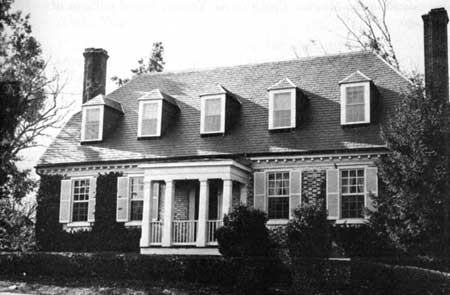
The Sessions Honse.
M. Sessions House. This house is the oldest building still standing in Yorktown. It was built in the late 17th century, and is named for its builder and first owner—Thomas Sessions.
Many of the houses mentioned here are private homes which are sometimes open during Garden Week and other special occasions. These old homes add charm to Yorktown and do much to preserve a quiet dignity along the narrow, shaded streets far removed from the busy thoroughfares of a 20th-century town.
For those interested in geology, mention should be made of the famous Yorktown Cliffs, particularly those in the area between Yorktown and the Moore House. In the steep banks eroded by the river, extensive and significant deposits of seashells are visible. These are of marine life that existed in the Miocene Epoch of the Tertiary Period millions of years ago.

|
|
Last Modified: Mon, Dec 2 2002 10:00:00 am PDT |


